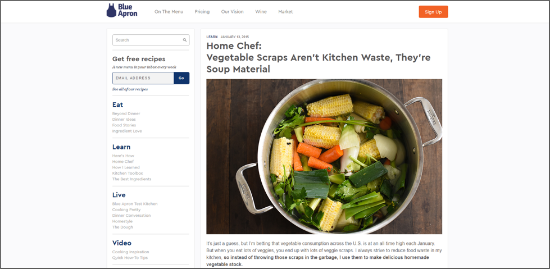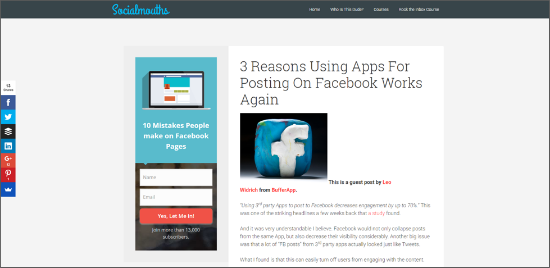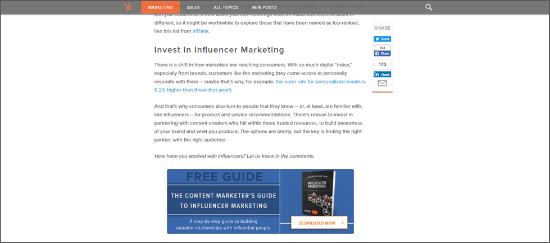[Editor’s Note: Please welcome me in joining Anne Leuman to TopRankBlog.com. Anne is a Copywriter that joined TopRank Marketing earlier this year and specializes in creating awesome B2B content for some of our amazing Enterprise clients.]
I’d venture to guess that you’re no stranger to content marketing. Content Marketing Institute reports that 89% of all organizations use content in their marketing efforts. But is content your main driver of growth? It might not be, and that’s okay, but we’re here to show you how successful content can be.
Take a look at startups for example. Startups are known for viral growth. To attract or keep investors, they need to grow at staggering rates. So how do they do it? A lot of them rely on content marketing. And with good reason.
There is no denying that content marketing is one of the most cost effective marketing tactics. In fact, Demand Metric reports that content marketing costs 62% less than traditional marketing and generates three times the leads. Yet, 52% of companies don’t have a formal content strategy.
If you’re looking to double down on your content strategy, see how these seven startups skyrocketed to success with content:
#1 – HubSpot
It’s hard to imagine HubSpot as a startup, but back in 2006 they were a fresh-faced business. And they grew on the back of quality, innovative content. They earn our #1 spot because over 75% of their generated leads come from content.
HubSpot accomplished this by offering free white papers, case studies, eBooks, and webinars, and hiding them behind a form. In order for visitors to get the free content, they had to provide their information and become a lead. In addition, HubSpot added a call to action at the bottom of every blog post. An action that tripled the amount of leads generated by their blog, according to HubSpot CMO Mike Volpe.
#2 – Blue Apron
Blue Apron, an ingredient and recipe delivery service, grew 500% in 2015. And they attributed that success to their content marketing strategies.
Blue Apron wanted to get subscribers excited about recipes before they showed up at their door, creating a more satisfying product experience. To do this, they created educational, fun cooking content including recipe histories, cooking techniques, and kitchen timesavers. With this method, they have engaged over 1.7 million Facebook fans to date.
Beyond engaging a larger audience and creating a better experience, educational content allowed Blue Apron to form more meaningful relationships with their subscribers. They became the go-to source for anything kitchen related, building trust and loyalty among their customers.

#3 – Mint
Content put the pressure on Mint’s competitors. When Mint, a personal finance app, started in 2007, blogging wasn’t widely adopted by companies. And if they did adopt it, they weren’t blogging often. Mint created the MintLife blog and steadily produced finance tips, videos, and news roundups. This gave Mint a competitive edge and allowed them to rank on search engines ahead of market leaders—including ranking number one for personal finance.
Oh, and this all happened before the launch of their product. With this strategy, they were able to have 20,000 subscribers before releasing their application. This allowed them to drive substantial traffic to the app on launch day. By 2009, Mint would be purchased by Intuit for $170 million. An achievement partially credited to their content strategy.
#4 – Buffer
Buffer, one of the most widely used social media tools today, was launched with content. At first, they pitched their app to well-known blogs and media outlets, hoping they would write about the tool and gain a large audience. But the big players turned them down. This forced their founder, Leo Widrich, to try gaining an audience another way.
Leo started guest blogging. He wrote over 150 posts on social media and published them on numerous blogs. By creating guest blogging relationships, Buffer gained the audience of other blogs and grew to 100,000 users in just 10 months. Guest blogging was the strategy that gave them the most initial growth.

#5 – Design Pickle
Imagine if your first 1,200 customers were generated solely by content. That was the case for Design Pickle and its founder Russ Perry.
Design Pickle was created to make graphic design a more convenient and available service. They started a subscription service where subscribers could receive unlimited graphic design help for one easy, flat rate.
Perry’s launch strategy centered around employing guest blogging. Russ wrote blog posts on marketing and design and posted them on affiliate blogs. Inside each post, Russ was able to offer promotions and information about his services. With this strategy, Design Pickle was able to capture their first 1,200 customers. They have now served over 100,000 project requests.

#6 – KISSmetrics
KISSmetrics, a marketing analytics platform, is one of the most popular marketing brands today. But it was a struggle to get it off the ground in 2008. Hiten Shah, co-founder of KISSmetrics, attributes their initial success to content curation and the new (at the time) microblogging platform, Twitter.
Blogging wasn’t popular when KISSmetrics was getting started—they didn’t even have one. So how did they gain an audience? They used curated content from Twitter and hashtags to reach large audiences and gain a following. Hiten says, “Sharing other marketers’ content was the perfect way to spread goodwill, promote great content, and build our own Twitter audience.” Eventually, their website was beaming with Twitter referrals. Since then, KISSmetrics has evolved to become blogging experts, with blogs accounting for over 70% of their leads and 82% of their website traffic.
#7 – Glossier
Experts in all things beauty, Glossier started out as a beauty blog called Into The Gloss, which still exists today. But it quickly grew into something more. Known for providing great advice from real women—Into The Gloss, started by Emily Weiss—was one of the largest skincare and makeup blogs. With a passion for beauty and a captive audience, Emily decided to use her blog to launch her own beauty line.
In writing her blog, Emily already had all of the market research she needed and began producing skincare and makeup products. She then directly involved Into The Gloss’s audience in her new venture by teasing her new brand, Glossier, and documenting the process. By the time she officially launched, Glossier had 15,000 followers who didn’t even know what it was. Her stellar content and engaged audience (including 500,000 Instagram followers) allowed her blog to turn into a successful retailer.

Implementing content marketing and doing it well has the power to propel your business to success. The (former) startups above are a testament to that. Check out these 10 infographics to elevate your content marketing even further.
Gain a competitive advantage by subscribing to the
TopRank® Online Marketing Newsletter.
© Online Marketing Blog - TopRank®, 2017. | How 7 Startups Skyrocketed to Success with Content Marketing | http://www.toprankblog.com
The post How 7 Startups Skyrocketed to Success with Content Marketing appeared first on Online Marketing Blog - TopRank®.


No comments:
Post a Comment